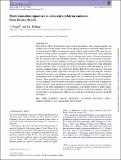Files in this item
Flash ionization signature in coherent cyclotron emission from brown dwarfs
Item metadata
| dc.contributor.author | Vorgul, Iryna | |
| dc.contributor.author | Helling, Christiane | |
| dc.date.accessioned | 2016-04-29T12:30:08Z | |
| dc.date.available | 2016-04-29T12:30:08Z | |
| dc.date.issued | 2016-05-01 | |
| dc.identifier | 242260534 | |
| dc.identifier | 1c12b1c9-c64b-4e9c-8a95-8e2834f70b55 | |
| dc.identifier | 84963743575 | |
| dc.identifier | 000374568900071 | |
| dc.identifier.citation | Vorgul , I & Helling , C 2016 , ' Flash ionization signature in coherent cyclotron emission from brown dwarfs ' , Monthly Notices of the Royal Astronomical Society , vol. 458 , no. 1 , pp. 1041-1056 . https://doi.org/10.1093/mnras/stw234 | en |
| dc.identifier.issn | 0035-8711 | |
| dc.identifier.other | RIS: urn:97AE757882FB78C4711A0A381700CE2C | |
| dc.identifier.uri | https://hdl.handle.net/10023/8703 | |
| dc.description | We gratefully acknowledge the support from the European Community under the FP7 by the ERC starting grant 257431 | en |
| dc.description.abstract | Brown dwarfs (BDs) form mineral clouds in their atmospheres, where charged particles can produce large-scale discharges in the form of lightning resulting in substantial sudden increase of local ionization. BDs are observed to emit cyclotron radio emission. We show that signatures of strong transient atmospheric ionization events (flash ionization) can be imprinted on a pre-existing radiation. Detection of such flash ionization events will open investigations into the ionization state and atmospheric dynamics. Such events can also result from explosion shock waves, material outbursts or (volcanic) eruptions. We present an analytical model that describes the modulation of a pre-existing electromagnetic radiation by a time-dependent (flash) conductivity that is characteristic for flash ionization events like lightning. Our conductivity model reproduces the conductivity function derived from observations of terrestrial gamma-ray flashes, and is applicable to astrophysical objects with strong temporal variations in the local ionization, as in planetary atmospheres and protoplanetary discs. We show that the field responds with a characteristic flash-shaped pulse to a conductivity flash of intermediate intensity. More powerful ionization events result in smaller variations of the initial radiation, or in its damping. We show that the characteristic damping of the response field for high-power initial radiation carries information about the ionization flash magnitude and duration. The duration of the pulse amplification or the damping is consistently shorter for larger conductivity variations and can be used to evaluate the intensity of the flash ionization. Our work suggests that cyclotron emission could be probe signals for electrification processes inside BD atmosphere. | |
| dc.format.extent | 16 | |
| dc.format.extent | 1942270 | |
| dc.language.iso | eng | |
| dc.relation.ispartof | Monthly Notices of the Royal Astronomical Society | en |
| dc.subject | Instabilities | en |
| dc.subject | Radiation mechanisms: non-thermal | en |
| dc.subject | Atmospheric effects | en |
| dc.subject | Methods: analytical | en |
| dc.subject | Stars: atmospheres | en |
| dc.subject | Brown dwarfs | en |
| dc.subject | QB Astronomy | en |
| dc.subject | QC Physics | en |
| dc.subject | NDAS | en |
| dc.subject.lcc | QB | en |
| dc.subject.lcc | QC | en |
| dc.title | Flash ionization signature in coherent cyclotron emission from brown dwarfs | en |
| dc.type | Journal article | en |
| dc.contributor.sponsor | European Research Council | en |
| dc.contributor.institution | University of St Andrews. School of Physics and Astronomy | en |
| dc.identifier.doi | 10.1093/mnras/stw234 | |
| dc.description.status | Peer reviewed | en |
| dc.identifier.grantnumber | 257431 257431 | en |
This item appears in the following Collection(s)
Items in the St Andrews Research Repository are protected by copyright, with all rights reserved, unless otherwise indicated.

